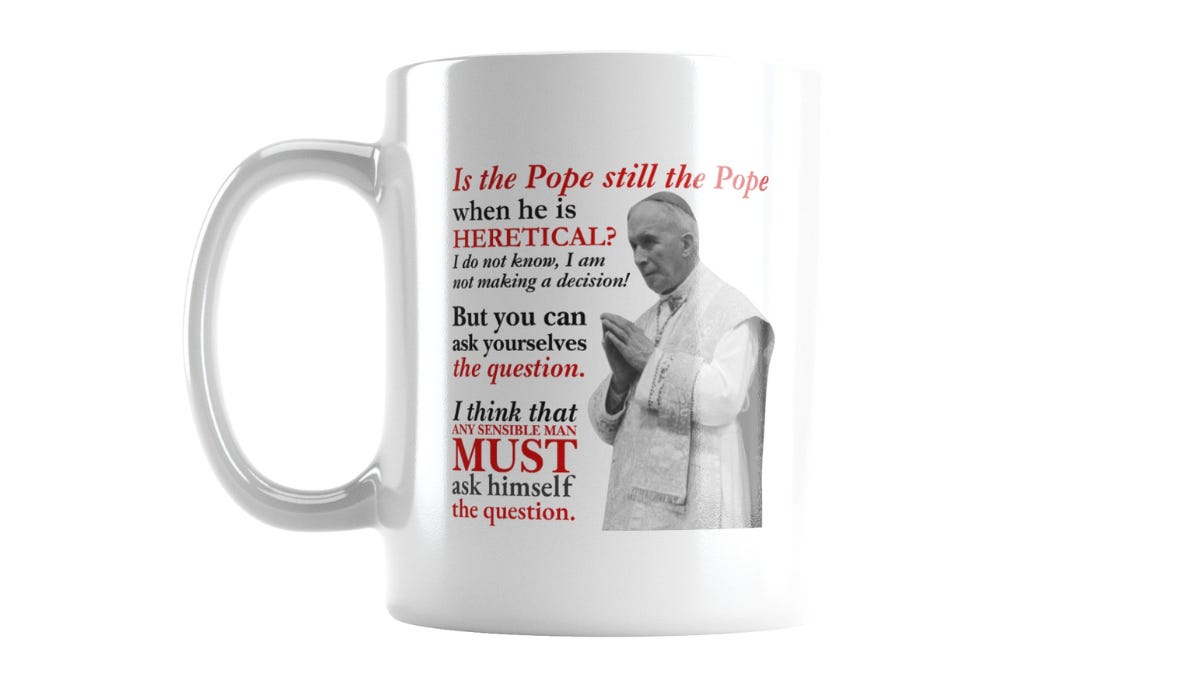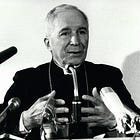'She is neither liberal, nor modernist, nor ecumenical' – Abp. Lefebvre on Our Lady
In his final years, Archbishop Marcel Lefebvre made several powerful remarks on the power of Our Lady against modernism and ecumenism.

In his final years, Archbishop Marcel Lefebvre made several powerful remarks on the power of Our Lady against modernism and ecumenism.
Editors’ Notes
Following the Vatican’s recent attempt to suppress Our Lady’s titles of “Co-Redemptrix”, “Mediatrix” and “Mediatrix of All Graces”, we have decided to interrupt our usual Monday schedule of Archbishop Lefebvre’s “hardline texts.”
Instead, we are providing a translation of some choice extracts from a 1989 sermon, and short extract from his 1990 work Itinéraire spirituel – in which the Archbishop made several memorable remarks about Our Lady’s opposition to modernism, liberalism, ecumenism and all forms of heresy.
Whatever readers think of Archbishop Lefebvre and his ideas, we hope that they find the below texts encouraging.
We have seen an incredible proliferation of insults given to our Co-Redemptrix and Mediatrix of All Graces – by the Vatican, and by gloating Protestants, Conciliar/Synodalists and (inexplicably) some “Eastern Orthodox” schismatics. In the face of this, it is our hope that Our Lady will demonstrate why she enjoys the title “Exterminatrix of All Heresies” – exterminating error, and obtaining light, grace, conversion and the salvation of the erring from her Divine Son.
As Cardinal Newman prayed, at the end of his Letter to Pusey:
“May that bright and gentle Lady, the Blessed Virgin Mary, overcome you with her sweetness, and revenge herself on her foes by interceding effectually for their conversion!”
See also:
Pentecost Sermon
On the role of Our Lady in the Church
14 May 1989
Translation by The WM Review
The day of Pentecost
Saint Luke, in recounting the events of Pentecost in the Acts of the Apostles, is, as is his custom, always very precise in his narration. After having named those who were present in the Cenacle, and after having named the apostles themselves, he adds the following:
Hi omnes erant perseverantes unanimiter in oratione cum mulieribus, et Maria Matre Jesu, et fratribus ejus (Acts 1:14).
These men – the apostles – persevered in prayer, united with the women who were with them, and in particular with Mary, the Mother of Jesus, and his relatives. As he will say elsewhere, they were about one hundred and twenty.
I wish especially to draw your attention to the presence of the most holy Virgin Mary. Yesterday, the 13th of May, we celebrated the apparition of Our Lady at Fatima. We held the procession in the evening and consecrated the seminary to the Immaculate Heart of Mary, in fulfilment of the desire of the most holy Virgin Mary.
It is said of the apostles, after they had received the Holy Ghost:
Et repleti sunt omnes Spiritu Sancto et cœperunt loqui (Acts 2:4). Et cœperunt loqui: “and they began to speak.”
The Spirit of Truth, the Spirit of holiness with which they were filled, urged them to communicate that same Holy Ghost which they had received – through speech.
Nothing is said of the most holy Virgin Mary; yet the Virgin Mary was in their midst, with them, at this memorable event.
Well then, let us not forget that it was through the Virgin Mary that the apostles received this Spirit of Truth and holiness. Yes, Mary was the channel through which the Holy Ghost descended upon the apostles and the disciples of Our Lord gathered in the Cenacle. The popes affirm this explicitly.
For Mary had already been filled with the Holy Ghost long before the apostles, long before Pentecost. The mere fact that the Angel Gabriel, when he came to announce to her the great news of her divine maternity, said: Ave Maria, gratia plena – “Hail Mary, full of grace” – shows this. Yes, she is full of grace; that is to say, full of the Holy Ghost, already filled with the Holy Ghost.
And the Angel adds:
Spiritus Sanctus superveniet in te:
“The Holy Ghost shall come upon you, and by the power of the Holy Ghost you shall be the Mother of Jesus.”
The most holy Virgin Mary had her Pentecost before the day of Pentecost. […]
[I]t is through Mary that the apostles were made the founders of the Church. And Mary does not err. And Mary is infallible. Mary cannot profess error; Mary cannot sin. She is holy; she is perfect; she is the light of Truth. And this is what she communicated to the apostles.
The opposition of the modernists to Our Lady
Now, my very dear brethren, as you know – these are historical facts – Mary was not present only at Pentecost. She did not wish merely to act upon the Church during the first fifteen years, while she was still on earth after the death of Jesus. She has continued through all the centuries to watch over her Church, to watch over her apostles. She has come again and again to remind the world of Truth – and the last time, precisely at Fatima. She revealed a secret which she wished to be made public in 1960. Why did the popes refuse to publish this secret?
I do not know whether you heard, when that meeting at Assisi took place, that certain faithful Catholics – though not belonging in any particular way to the movement of Tradition – had wished, since there was to be a great gathering at Assisi, that Our Lady of Fatima might come to Assisi. There was a procession organised by Italian faithful who came bringing a statue of the Virgin Mary to Assisi. They were turned away. They did not want the Virgin Mary at Assisi.
Mary asked that the pope and all the bishops consecrate the world, and more particularly Russia, to her Immaculate Heart and to the Heart of Jesus.
It is not done. They refuse to do what Mary asks. There is therefore a real opposition to the Virgin Mary – because the Virgin Mary is not ecumenical. The Virgin Mary knows only Jesus, the Spirit of Truth, and the Spirit of holiness. These are the foundation of the Church; they are what the Church herself is.
The opposition of Our Lady to the modernists – and all error and sin
We wish to be with the Virgin Mary. We wish to be at Pentecost, with the apostles, with the Virgin Mary, in the Spirit of Truth and in the Spirit of holiness, which is the spirit of the Church. And we do not wish to change it. Whatever authorities may try to make us change this spirit, we refuse. We wish to remain Catholic. We do not wish to become liberal, nor modernist, nor Protestant.
And the Virgin Mary will help us. Because the Virgin Mary is allergic to error, allergic to sin. She cannot bear error. She is Truth. She is opposed to heresy. She is opposed, by her very nature, to all that opposes Truth. She is opposed to all that opposes holiness, to every sin whatever it may be – even the least venial sin, the slightest sin of negligence – she is allergic, because she remains holy; she wills to remain in Truth.
Let us ask her to communicate this allergy to us. Father Garrigou-Lagrange calls her Our Lady of Horror. What does he mean by this? He says Our Lady of Horror – yes, because the Virgin Mary has a horror of error and a horror of sin. It is in her nature. She cannot bear error; she cannot bear sin. For error and sin are the devil. He is the one who introduced them into the world. Therefore she is allergic to the devil.
You know well that she was created to crush the head of the serpent, to bring Satan and all the servants of Satan to nothing.
Then let us unite ourselves with the Virgin Mary. Let us remain closely united to her, and she will preserve us from error and from sin; she will keep us in Truth and in holiness.1
The Virgin Mary
From Itinéraire spirituel – According to St Thomas Aquinas (1990)
Translation and headings by The WM Review.
Saint Thomas evokes the great privileges of the Virgin Mary on the occasion of the mission of the Word in this world through his Incarnation (IIIa, qq. 31–35).
The place of Mary in the accomplishment of the work of the salvation of mankind by the Incarnate Word is such that she deserves to be spoken of in a manner altogether particular.
If Mary, by her fiat, became miraculously the Mother of God, the Mother of the Saviour, she became by that very fact the Mother of his Mystical Body – that is to say, of all those who will live by the life of Jesus here below and in eternity – the Queen of angels and the definitive enemy of demons.
We have become her children through baptism, and [in a manner of speaking, because it is the flesh and blood of her son,] we are nourished by her flesh and by her blood in the Eucharist.2 She is truly our spiritual Mother.
This divine maternity has procured for her unique privileges: first, her Immaculate Conception, with the plenitude of grace from the very instant of her conception. She is the only human creature exempt from the consequences of original sin.
Another unheard-of privilege: she is the Mother of Jesus and remains virgin before, during, and after her childbearing. Nothing is impossible to God, as the Angel Gabriel said to her. The Child Jesus came forth from the womb of the Virgin januis clausis – with the doors closed – without destroying the physical seal of her virginity; she did not suffer the pains of childbirth. What errors abound on this subject in modern catechisms!
She was therefore exempt from every venial fault and from every sickness, which are consequences of original sin.
Finally, her body, being not subject to corruption, was raised up and ascended into Heaven: this is the privilege of the Assumption; she is henceforth the Queen of Heaven and of Earth.
She is also, by virtue of her divine Maternity, the Mediatrix of all the Graces that are given to us; her spiritual Maternity is universal. If Jesus is the Head of the Mystical Body, Mary is its neck, as the Fathers of the Church say.
Mary, being the Mother of the Eternal Priest, exercises a particular maternity over all those who share in the priesthood of Jesus. May the Virgin Mary deign to form in us priests in the likeness of her divine Son! May devotion to Mary be held in honour in all the houses of the Fraternity and in the hearts of all its members!
Mary will keep us in the Catholic faith. She is neither liberal, nor modernist, nor an ecumenist. She is allergic to all errors, and still more to heresies and to apostasy.
[We shall read with profit the books of Saint Louis-Marie Grignion de Montfort, as well as the works of Father Terrien on the glories of Mary.]
Allow me to praise thee, holy Virgin.
Give me strength against thy enemies!Rejoice, O Virgin Mary, for thou alone thou hast destroyed all heresies throughout the world.
HELP KEEP THE WM REVIEW ONLINE WITH WM+!
As we expand The WM Review we would like to keep providing free articles for everyone.
Our work takes a lot of time and effort to produce. If you have benefitted from it please do consider supporting us financially.
A subscription gets you access to our exclusive WM+ material, and helps ensure that we can keep writing and sharing free material for all.
You can see what readers are saying over at our Testimonials page.
And you can visit The WM Review Shop for our ‘Lovely Mugs’ and more.
(We make our WM+ material freely available to clergy, priests and seminarians upon request. Please subscribe and reply to the email if this applies to you.)
Subscribe to WM+ now to make sure you always receive our material. Thank you!
If you liked this article, why not get it in mug form?
Get your Archbishop Lefebvre Mug today:
Or why not our best-selling Co-Redemptrix Mug?
Read Next:
The WM Review Lefebvre Archive
The WM Review Blessed Virgin Mary Archive
See also:
Follow on Twitter, YouTube and Telegram:
Twitter (The WM Review)
Regrettably, this sermon also contains a number of ideas about the crisis of the Church which we do not wish to reproduce here.
As stated in a dedicated article on the topic, our aim for the Monday schedule of texts has not been to present the Archbishop as either a) an authority to whose views Catholics can or should conform, or b) being wholly on one or other side of the key questions of our day. We have explicitly acknowledged that there were indeed two sides or “poles,” between which he appeared to shift at times.
Our purpose, rather, has been to critique the contemporary “whitewashing” of Archbishop Lefebvre, and to demonstrate that he himself expressed many of the ideas which certain revisionists seek to anathematise. Historically speaking, many who hold such ideas learned them from such texts – and are not to be blamed for seeing their intrinsic truth and embracing them, even if Archbishop Lefebvre did not definitively do so himself.
To that end, translating the full sermon is outside the scope of our schedule. In addition, the Archbishop’s expression of such ideas already have more than adequate representation elsewhere, and those who wish to read it may translate it themselves.
Readers can see more on this general issue here:
While there is a sense in which Lefebvre’s image here is true and beautiful, this is nonetheless an infelicitous statement. Cardinal John Henry Newman’s Letter to Pusey contains the following text from Raynaud:
“Let this be taken for granted, that no praises of ours can come up to the praises due to the Virgin Mother. But we must not make up for our inability to reach her true praise, by a supply of lying embellishment and false honours. For there are some whose affection for religious objects is so imprudent and lawless, that they transgress the due limits even towards the saints. […]
“Nor is that honour of the Deipara to be offered, viz. that the elements of the body of Christ, which the Blessed Virgin supplied to it, remain perpetually unaltered in Christ, and thereby are found also in the Eucharist... This solicitude for the Virgin’s glory must, I consider, be discarded; since, if rightly considered, it involves an injury towards Christ, and such honour the Virgin loveth not.
“And first, dismissing philosophical bagatelles about the animation of blood, milk, &c., who can endure the proposition that a good portion of the substance of Christ in the Eucharist should be worshipped with a cultus less than latria? viz. by the inferior cultus of hyperdulia?
“The preferable class of theologians contend that not even the humanity of Christ, is to be materially abstracted from the Word of God, and worshipped by itself; how then shall we introduce a cultus of the Deipara in Christ, which is inferior to the cultus proper to Him? How is this other than a casting down of the substance of Christ from His Royal Throne, and a degradation of it to some inferior sitting place? It is nothing to the purpose to refer to such Fathers, as say that the flesh of Christ is the flesh of Mary, for they speak of its origin.
“What will hinder, if this doctrine be admitted, our also admitting that there is something in Christ which is detestable? for, as the first elements of a body which were communicated by the Virgin to Christ, have (as these authors say) remained perpetually in Christ, so the same materia, at least in part, which belonged originally to the ancestors of Christ, came down to the Virgin from her father, unchanged, and taken from her grandfather, and so on. And thus, since it is not unlikely that some of these ancestors were reprobate, there would now be something actually in Christ, which had belonged to a reprobate, and worthy of detestation.”
Newman, Letter to Pusey, pp. 110, 112-3.



